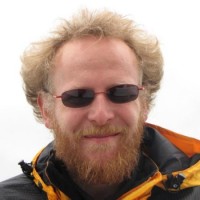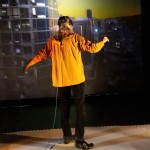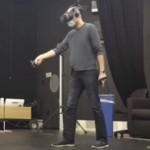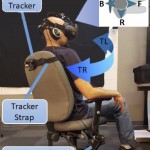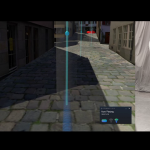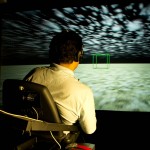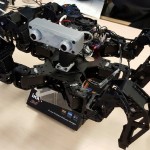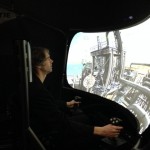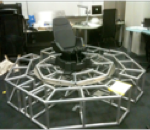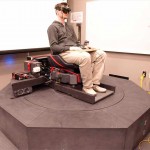Markus von der Heyde
Biography
collaborator on various projects.
Projects
HyperJumping in Virtual Vancouver: Combating Motion Sickness by Merging Teleporting and Continuous VR Locomotion in an Embodied Hands-Free VR Flying Paradigm
Motion sickness, unintuitive navigation, and limited agency are critical issues in VR/XR impeding wide-spread adoption and enjoyable user experiences. To tackle these challenges, we present HyperJump, a novel VR interface merging advantages ...
Can more embodied and leaning-based interfaces help support concurrent locomotion and interaction in VR when physical walking isn't feasible?
Physical walking is often considered the gold standard for VR travel whenever feasible. However, especially for larger-scale virtual travel the free-space walking areas are typically too small, thus requiring handheld controllers to navigate, which ...
Hand-held VR controllers are widely available and used, however they can contribute to unwanted side-effects, such as increased cybersickness, disorientation, and cognitive load. Here, we show how a leaning-based interfaces ("HeadJoystick") can help improve user experience, usability,and performance in diverse ground-based navigation including three complementary tasks: reach-the-target, follow-th...
Here we propose a hybrid interface that allows user to seamlessly transition between a slow 'continuous' mode and a fast 'hyperjump' mode. The interface aims to maintain the immersion, presence, accuracy and spatial updating of continuous locomotion while adding the travel efficiency and minimizing the cybersickness.
Continuous locomotion in VR provides uninterrupted optical flow, which mimics re...
How do we best design locomotion interfaces for VR that provide "enough" physical motion cues (vestibular/proprioceptive) while still being effective, affordable, compact, and safe?
Despite amazing progress in computer graphics and VR displays, most affordable and room-sized VR locomotion interfaces provide only little physical motion cues (e.g., vestibular & proprioceptive cues). To provide...
Developing virtual interfaces for embodied tele-operation and locomotion.
How can we best design and implement an embodied telepresence system for tele-robotics, so we can safely explore remote, hard-to-reach, or potentially hazardous areas or situations?
The goal of the "TeleSpider" project is to design and implement a telepresence system where users can remotely operate a robotic spid...
Using motion seats for enhancing locomotion and immersion in VR
How can we provide a "moving experience" through VR without having to use a full-scale motion platform?
Could a compact and relatively low-cost "motion seat" provide some of the same benefits, thus reducing cost, complexity, space & safety requirements?
Despite considerable advances in Simulation and Virtual Real...
Collaboration between the iSpace lab at SIAT and Mechatronics Undergraduate Interns to design and build a unique, virtual reality multi-modal motion simulator
The iSpace program is centered on investigating what constitutes effective, robust, and intuitive human spatial orientation and behaviour. This fundamental knowledge will be applied to design novel, more effective human-computer interfaces ...
How important are physical motions for effective spatial orientation in VR?
Most virtual reality simulators have a serious flaw: Users tend to get easily lost and disoriented as they navigate. According to the prevailing opinion, this is because physical motion cues are absolutely required for staying oriented while moving. In this study, we investigated how physical motion cues contribute ...
Publications
http://ispace.iat.sfu.ca/wp-content/plugins/zotpress/
37904
Schulte-Pelkum, J., Riecke, B. E., von der Heyde, M., & Bülthoff, H. H. (2004). Influence of display device and screen curvature on perceiving and controlling simulated ego-rotations from optic flow. Tech. rep., Max Planck Institute for Biological Cybernetics, T\übingen, Germany; Google Scholar.
37904
Riecke, B. E., Veen, H. A. H. C. van, & Bülthoff, H. H. (2000). Visual Homing is possible without Landmarks: A Path Integration Study in Virtual Reality. In M. von der Heyde & H. H. Bülthoff (Eds.), Perception and Action in Virtual Environments (pp. 97–134). Cognitive and Computational Psychophysics Department.
37904
Riecke, Bernhard E., Jörg Schulte-Pelkum, Marios N Avraamides, Markus Von Der Heyde, and Heinrich H Bülthoff. 2006. “Cognitive Factors Can Influence Self-Motion Perception (Vection) in Virtual Reality.” ACM Transactions on Applied Perception (TAP) 3 (July):194–216. https://doi.org/10.1145/1166087.1166091.
37904
Riecke, Bernhard E., Markus Von Der Heyde, and Heinrich H Bülthoff. 2005. “Visual Cues Can Be Sufficient for Triggering Automatic, Reflexlike Spatial Updating.” ACM Transactions on Applied Perception (TAP) 2 (July):183–215. https://doi.org/10.1145/1077399.1077401.
37904
Stepanova, E. R., Heyde, M. von der, Kitson, A., Schiphorst, T., & Riecke, B. E. (2017). Gathering and Apply Guidelines for TeleSpider Design for Urban Search and Rescue Applications on a Mobile Robot. In M. Kurosu (Ed.), Human-Computer Interaction. Interaction Contexts (HCI 2017) (Vol. 10272, pp. 562–581). Springer.
37904
Heyde, M. von der, B. E. Riecke, D. W. Cunningham, and H. H. Bülthoff. 2001. “Visual-Vestibular Sensor Integration Follows a Max-Rule: Results from Psychophysical Experiments in Virtual Reality.” In VisionScienceS01, edited by K. Nakayama et al, 142. VisionScienceS Meeting. Sarasota, Florida, United States.
37904
Heyde, M. von der, B. E. Riecke, D. W. Cunningham, and H. H. Bülthoff. 2001. “No Visual Dominance for Remembered Turns - Psychophysical Experiments on the Integration of Visual and Vestibular Cues in Virtual Reality.” In VisionScienceS01, edited by K. Nakayama et al. Vol. 1. VisionScienceS Meeting. Sarasota, Florida, United States. https://doi.org/doi:10.1167/1.3.188.
37904
Adhikari, Ashu, Daniel Zielasko, Alexander Bretin, Markus von der Heyde, Ernst Kruijff, and Bernhard E. Riecke. 2021. “Integrating Continuous and Teleporting VR Locomotion into a Seamless ‘HyperJump’ Paradigm.” In 2021 IEEE Conference on Virtual Reality and 3D User Interfaces Abstracts and Workshops (VRW), 370–72. Lisbon, Portugal: IEEE. https://doi.org/10.1109/VRW52623.2021.00074.
37904
Schulte-Pelkum, J., B. E. Riecke, M. von der Heyde, and H. H. Bülthoff. 2003. “Screen Curvature Does Influence the Perception of Visually Simulated Ego-Rotations.” Journal of Vision, Poster presented at VSS, 3 (9). https://doi.org/doi: 10.1167/3.9.411.
37904
Riecke, B. E, M. von der Heyde, and H. H Bülthoff. 2001. “How Real Is Virtual Reality Really? Comparing Spatial Updating Using Pointing Tasks in Real and Virtual Environments.”
Journal of Vision 1 (3): 321a.
http://www.kyb.mpg.de/publication.html?publ=629.
37904
Riecke, B. E., J. Schulte-Pelkum, M. N. Avraamides, M. von der Heyde, and H. H. Bülthoff. 2004. “The Effect of Cognition on the Visually Induced Illusion of Self-Motion (Vection).” Journal of Vision 4 (8): 891a. https://doi.org/10.1167/4.8.891.
37904
Heyde, M. von der, B. E. Riecke, D. W. Cunningham, and H. H. Bülthoff. 2000. “Humans Can Separately Perceive Distance, Velocity, and Acceleration from Vestibular Stimulation.” Poster presented at the 3. Tübinger Wahrnehmungskonferenz (TWK), Tübingen, Germany.
37904
Schulte-Pelkum, J., Bernhard E. Riecke, and M. von der Heyde. 2004. “Ein Kognitiver Einfluss Auf Die Wahrnehmung von Simulierter Eigenbewegung (Zirkularvektion).” Poster presented at the Tagung experimentell arbeitender Psychologen (TeaP), Giessen, Germany.
37904
Riecke, B. E., and M. von der Heyde. 2003. “Qualitative Modeling of Spatial Orientation Processes Using a Logical Network of Necessary and Sufficient Conditions.” Poster presented at the Object Perception and Memory (OPAM), Vancouver, Canada.
37904
Schulte-Pelkum, J., B. E Riecke, and M. von der Heyde. 2003. “Influence of Display Parameters on Perceiving Visually Simulated Ego-Rotations - a Systematic Investigation.” Poster presented at the Tübingen Perception Conference (TWK), Tübingen, Germany.
37904
Riecke, B. E, M. von der Heyde, and H. H Bülthoff. 2002. “Spatial Updating Experiments in Virtual Reality: What Makes the World Turn around in Our Head?” Poster presented at the 5. Tübinger Wahrnehmungskonferenz (TWK), Tübingen, Germany.
37904
Riecke, B. E., J. Schulte-Pelkum, M. N Avraamides, M. von der Heyde, and Heinrich H Bülthoff. 2004. “Top-down Influence on Visually Induced Self-Motion Perception (Vection).” Poster presented at the 7. Tübingen Perception Conference (TWK), Tübingen, Germany.
37904
Heyde, M. von der, B. E. Riecke, D. W. Cunningham, and H. H. Bülthoff. 2000. “Humans Can Extract Distance and Velocity from Vestibular Perceived Acceleration.” Poster presented at the Cognitive Neuroscience Meeting; Journal of Cognitive Neuroscience, 63C 77.
37904
Riecke, B. E, M. von der Heyde, and Heinrich H Bülthoff. 2001. “How Do We Know Where We Are? Contribution and Interaction of Visual and Vestibular Cues for Spatial Updating in Real and Virtual Environments.” Poster presented at the Tübinger Wahrnehmungskonferenz (TWK), Tübingen, Germany.
37904
Riecke, B. E., M. von der Heyde, and Heinrich H Bülthoff. 2002. “Spatial Updating Experiments in Virtual Reality: What Makes the World Turn around in Our Head.” Poster 162 presented at the Tübinger Wahrnehmungskonferenz (TWK), Tübingen, Germany.
http://3t.kyb.tuebingen.mpg.de/de/publication.html?publ=632.
37904
Schulte-Pelkum, J., B. E. Riecke, M. von der Heyde, and H. H. Bülthoff. 2002. “Perceiving and Controlling Simulated Ego-Rotations from Optic Flow: Influence of Field of View and Display Devices on Ego-Motion Perception.” Poster presented at the Object Perception and Memory (OPAM), Kansas City, MO, USA.
37904
Riecke, B. E, M. von der Heyde, and Heinrich H Bülthoff. 2002. “Spatial Updating in Virtual Environments: What Are Vestibular Cues Good For.” Talk presented at the VSS.
http://journalofvision.org/2/7/421/.
37904
Riecke, B. E, M. von der Heyde, and H. H Bülthoff. 2002. “Teleporting Works - Spatial Updating Experiments in Virtual Tübingen.” Talk presented at the Object Perception and Memory (OPAM), Kansas City, USA.
37904
Riecke, B.E., and Markus von der Heyde. 2000. “Spatial Updating – Interaktion Visueller Und Vestibulärer Reize Bei Der Räumlichen Orientierung.” Talk presented at the 1. SFB 550 Nachwuchskongress, Oberjoch, Germany.
37904
Riecke, Bernhard E., M. von der Heyde, and H. H Bülthoff. 2002. “Contribution and Interaction of Visual and Vestibular Cues for Spatial Updating in Real and Virtual Environments.” Talk presented at the 43. Kongress der Deutschen Gesellschaft für Psychologie (DGPS), Lengerich, Germany.
37904
Riecke, B. E, M. von der Heyde, and Heinrich H Bülthoff. 2002. “Teleporting Works-Spatial Updating Experiments in Virtual Tübingen.” Talk presented at the Object Perception and Memory (OPAM), Kansas City, MO, USA.
37904
Schulte-Pelkum, J., B. E. Riecke, M. von der Heyde, and H. H. Bülthoff. 2003. “Circular Vection Is Facilitated by a Consistent Photorealistic Scene.” Talk presented at the Presence 2003 Conference, Aalborg, Denmark.
37904
Heyde, M. von der, & Riecke, B. E. (2001). How to cheat in motion simulation - comparing the engineering and fun ride approach to motion cueing (No. 89). Max Planck Institute for Biological Cybernetics, Tübingen, Germany.
37904
Riecke, B. E., & Heyde, M. von der. (2002). Qualitative Modeling of Spatial Orientation Processes using Logical Propositions: Interconnecting Spatial Presence, Spatial Updating, Piloting, and Spatial Cognition (Technical Report No. 100; Max Planck Institute for Biological Cybernetics, pp. 1–17). MPI for Biological Cybernetics.
37904
Riecke, B. E., Heyde, M. von der, & Clement, D. (2022). Methods and Systems for Hybrid Virtual Reality Travel User Interface (Patent nonprovisional patent)).
37904
Riecke, Bernhard E, David Clement, Denise Quesnel, Ashu Adhikari, Daniel Zielasko, and Markus von der Heyde. 2022. “HyperJumping in Virtual Vancouver: Combating Motion Sickness by Merging Teleporting and Continuous VR Locomotion in an Embodied Hands-Free VR Flying Paradigm.” In Siggraph ’22 Immersive Pavilion, 1–2. Vancouver, BC, Canada: ACM. https://doi.org/10.1145/3532834.3536211.
37904
Kitson, Alexandra, Timofey Y. Grechkin, Markus von der Heyde, and Bernhard E. Riecke. 2017. “Navigating Virtual Environments – Do Physical Rotations Aid in Orientation?” Poster presented at the Second International Workshop on Models and Representations in Spatial Cognition, Tübingen, Germany, April 6.
37904
Kitson, Alexandra, Timofey Y. Grechkin, M. von der Heyde, and Bernhard E Riecke. 2016. “Effect of Physical Rotations and Gender for Navigation Performance in Virtual Environments.” Poster presented at the International Meeting of the Psychonomic Society, Granada, Spain, May.
http://www.ps2016.org/.
37904
Riecke, Bernhard E., Ashu Adhikari, Daniel Zielasko, Alexander Bretin, Markus von der Heyde, and Ernst Kruijff. 2021. “HyperJump: Merging Teleporting and Continuous VR Locomotion into One Paradigm.” Talk presented at the ICSC 2021: 8th International Conference on Spatial Cognition, Rome, Italy.
37904
Riecke, Bernhard E, Abraham M Hashemian, Ashu Adhikari, Ivan Aguilar, Ernst Kruijff, and Markus von der Heyde. 2021. “Simultaneous Locomotion and Interaction in VR: Walking > Leaning > Controller.” Talk presented at the ICSC 2021: 8th International Conference on Spatial Cognition, Rome, Italy.
https://youtu.be/jzoaBAd6gPY.
37904
Adhikari, Ashu, Bernhard E. Riecke, Abraham M. Hashemian, Thinh Nguyen-Vo, Ernst Kruijff, and Markus von der Heyde. 2021. “Embodied VR Flying Improves Spatial Orientation While Reducing Cybersickness.” Talk presented at the ICSC 2021: 8th International Conference on Spatial Cognition, Rome, Italy.
https://youtu.be/FbmE4SEISWU.
37904
Hashemian, Abraham M., Ashu Adhikari, Alexander Bretin, Ivan Aguilar, Ernst Kruijff, Markus von der Heyde, and Bernhard E. Riecke. 2021. “Is Walking Necessary for Effective Locomotion and Interaction in VR?” In 2021 IEEE Conference on Virtual Reality and 3D User Interfaces Abstracts and Workshops (VRW), 395–96. Lisbon, Portugal: IEEE. https://doi.org/10.1109/VRW52623.2021.00084.
37904
Adhikari, Ashu, Daniel Zielasko, Ivan Aguilar, Alexander Bretin, Ernst Kruijff, Markus von der Heyde, and Bernhard E. Riecke. 2022. “Integrating Continuous and Teleporting VR Locomotion into a Seamless ‘HyperJump’ Paradigm.” IEEE Transaction on Visualization and Computer Graphics TVCG 29 (12): 5265–81. https://doi.org/10.1109/TVCG.2022.3207157.
37904
Adhikari, Ashu, Abraham M. Hashemian, Thinh Nguyen-Vo, Ernst Kruijff, Markus von der Heyde, and Bernhard E. Riecke. 2021. “Lean to Fly: Leaning-Based Embodied Flying Can Improve Performance and User Experience in 3D Navigation.” Frontiers in Virtual Reality 2:1–22. https://doi.org/10.3389/frvir.2021.730334.
37904
Hashemian, Abraham M., Ashu Adhikari, Ernst Kruijff, Markus von der Heyde, and Bernhard E. Riecke. 2021. “Leaning-Based Interfaces Improve Ground-Based VR Locomotion in Reach-the-Target, Follow-the-Path, and Racing Tasks.” IEEE Transaction on Visualization and Computer Graphics TVCG, 1–22. https://doi.org/10.1109/TVCG.2021.3131422.
37904
Hashemian, Abraham M, Ashu Adhikari, Ivan A Aguilar, Ernst Kruijff, Markus von der Heyde, and Bernhard E. Riecke. 2024. “Leaning-Based Interfaces Improve Simultaneous Locomotion and Object Interaction in VR Compared to the Handheld Controller.” IEEE Transactions on Visualization and Computer Graphics (TVCG) 30 (8): 4665–82. https://doi.org/10.1109/TVCG.2023.3275111.
